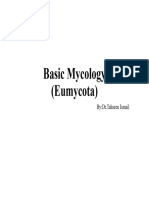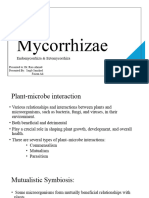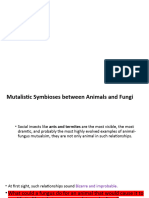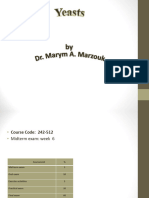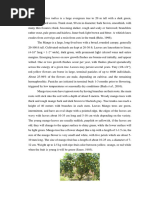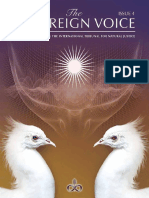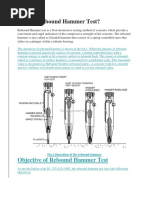100%(1)100% found this document useful (1 vote)
58 viewsThe Rhizosphere: A Playground and Battlefield For Soilborne Pathogens and Beneficial Microorganisms
The Rhizosphere: A Playground and Battlefield For Soilborne Pathogens and Beneficial Microorganisms
Uploaded by
wafiyyatunnufusThe rhizosphere is a region of intense microbial activity and interaction, as microbes are attracted to nutrients released by plant roots. It serves as an environment where both pathogenic and beneficial microbes interact with plants. Soilborne pathogens like fungi, oomycetes, bacteria, viruses, and nematodes can infect roots and spread through the plant. However, other microbes like nitrogen-fixing bacteria and mycorrhizal fungi benefit the plant. The rhizosphere is thus a battlefield where many microbial groups influence plant health and growth.
Copyright:
© All Rights Reserved
Available Formats
Download as PPTX, PDF, TXT or read online from Scribd
The Rhizosphere: A Playground and Battlefield For Soilborne Pathogens and Beneficial Microorganisms
The Rhizosphere: A Playground and Battlefield For Soilborne Pathogens and Beneficial Microorganisms
Uploaded by
wafiyyatunnufus100%(1)100% found this document useful (1 vote)
58 views17 pagesThe rhizosphere is a region of intense microbial activity and interaction, as microbes are attracted to nutrients released by plant roots. It serves as an environment where both pathogenic and beneficial microbes interact with plants. Soilborne pathogens like fungi, oomycetes, bacteria, viruses, and nematodes can infect roots and spread through the plant. However, other microbes like nitrogen-fixing bacteria and mycorrhizal fungi benefit the plant. The rhizosphere is thus a battlefield where many microbial groups influence plant health and growth.
Original Title
The rhizosphere
Copyright
© © All Rights Reserved
Available Formats
PPTX, PDF, TXT or read online from Scribd
Share this document
Did you find this document useful?
Is this content inappropriate?
The rhizosphere is a region of intense microbial activity and interaction, as microbes are attracted to nutrients released by plant roots. It serves as an environment where both pathogenic and beneficial microbes interact with plants. Soilborne pathogens like fungi, oomycetes, bacteria, viruses, and nematodes can infect roots and spread through the plant. However, other microbes like nitrogen-fixing bacteria and mycorrhizal fungi benefit the plant. The rhizosphere is thus a battlefield where many microbial groups influence plant health and growth.
Copyright:
© All Rights Reserved
Available Formats
Download as PPTX, PDF, TXT or read online from Scribd
Download as pptx, pdf, or txt
100%(1)100% found this document useful (1 vote)
58 views17 pagesThe Rhizosphere: A Playground and Battlefield For Soilborne Pathogens and Beneficial Microorganisms
The Rhizosphere: A Playground and Battlefield For Soilborne Pathogens and Beneficial Microorganisms
Uploaded by
wafiyyatunnufusThe rhizosphere is a region of intense microbial activity and interaction, as microbes are attracted to nutrients released by plant roots. It serves as an environment where both pathogenic and beneficial microbes interact with plants. Soilborne pathogens like fungi, oomycetes, bacteria, viruses, and nematodes can infect roots and spread through the plant. However, other microbes like nitrogen-fixing bacteria and mycorrhizal fungi benefit the plant. The rhizosphere is thus a battlefield where many microbial groups influence plant health and growth.
Copyright:
© All Rights Reserved
Available Formats
Download as PPTX, PDF, TXT or read online from Scribd
Download as pptx, pdf, or txt
You are on page 1of 17
The rhizosphere: a playground
and battlefield for soilborne
pathogens and beneficial
microorganisms
Jos M. Raaijm akers & Timothy C. Paulit z &
Christi an Steinberg & Cla ude Alabou vette &
Yvan M oënne-Loccoz
• The rhizosphere is a hot spot of microbial interactions as exudates
released by plant roots are a main food source for microorganisms
and a driving force of their population density and activities.
• The rhizosphere harbors many organisms that have a neutral effect on
the plant , but also attracts organisms that exert deleterious or
beneficial effects on the plant.
• Microorganisms that adversely affect plant growth and health are the
pathogenic, oomycetes, bacteria and nematodes.
• Most of the soilborne pathogens are adapted to grow and survive in
the bulk soil, but the rhizosphere is the playground and infection
court where the pathogen establishes a parasitic relationship with the
plant.
• The rhizosphere is also a battlefield where the complex rhizosphere
community, both microflora and microfauna, interact with pathogens
and influence the outcome of pathogen infection. A wide range of
microorganisms are beneficial to the plant and include nitrogen-fixing
bacteria, endo-and ectomycorrhizal fungi, and plant growth-
promoting bacteria and fungi.
• The rhizosphere is an environment that the plant itself helps to create
and where pathogenic and beneficial microorganisms constitute a
major influential force on plant growth and health (Lynch 1990 ).
• Microbial groups and other agents found in the rhizosphere include
bacteria, fungi, nematodes, protozoa, algae and microarthropods
(Lynch 1990 ; Raaijmakers 2001 ).
• Many members of this community have a neutral effect on the plant,
but are part of the complex food web that utilizes the large a mount
of carbon that is fixed by the plant and released into the rhizosphere
(i.e. rhizodeposits).
• The microbial community in the rhizosphere also harbors members that
exert deleterious or beneficial effects on the plant.
• Microorganisms that adversely affect plant growth and health are the
pathogenic fungi, oomycetes, bacteria and nematodes, whereas
microorganisms that are beneficial include nitrogen fixing bacteria,
endo and ectomycorrhizal fungi, and plant growth-promoting
rhizobacteria (PGPR) and fungi.
• The number and diversity of deleterious and beneficial microorganisms
are related to the quantity and quality of the rhizodeposits and to the
outcome of the microbial interactions that occur in the rhizosphere
• There are four main groups of plant pathogens (Agrios 2005 ), but
only two of them are major players in the soil : fungi (true fungi and
oomycetes) and nematodes.
• Only a few groups of bacteria are considered to be soilborne,
probably because non-spore forming bacteria cannot survive well in
soil for long periods.
• Bacteria also require a wound or natural opening to penetrate into
the plant and cause infection.
• Examples are Ralstonia solanacearum, cause of bacterial wilt of
tomato, and Agrobacterium tumefaciens, the well-studied causal
agent of crown gall.
• Some filamentous bacteria (Streptomyces) can also infect plants and
are better adapted to survive in the soil.
• Only a few viruses can infect roots. Like bacteria, they require a
wound to infect the plant and are mostly transmitted by vectors.
• In soil, they can be transmitted by nematodes (Nepoviruses or by
zoosporic fungi such as Olpidium and Polymyxa)
• Nematodes are complex, worm-like eukaryotic invertebrate animals
and probably among the most numerous animals on the planet.
• Most nematodes in soil are free-living, consuming bacteria, fungi, and
other nematodes, but some can parasitize plants.
• Some feed on the outside of the root (migratory ectoparasitic), some
penetrate and move in the interior of the root (migratory
endoparasitic), and some set up a feeding site in the interior of the
root and remain there for reproduction (sedentary endoparasites).
• Fungi and oomycetes are the most important soilborne pathogens.
• Fungi are eukaryotic, filamentous, multicellular, heterotrophic
organisms that produce a network of hyphae called the mycelium and
absorb nutrients from the surrounding substrate.
• Oomycetes have a morphology similar to fungi , but are
phylogenetically more closely related to brown algae. They produce
swimming spores (zoospores) and contain cellulose in their cell walls
as opposed to chitin in true fungi .
• Almost all soilborne fungi are necrotrophic, meaning they kill host
tissue with enzymes and toxins in advance of the hyphae and do not
require a living cell to obtain nutrients .
• Most of the biotrophic pathogens, such as rusts and powdery
mildews, occur on the above-ground portions of the plants and
require a living cell to obtain nutrients.
• A few root pathogens such as Phytophthora sojae are semibiotrophic.
• Surprisingly few root pathogens are biotrophic. Some examples are
lower zoosporic fungi and Oomycetes, such as Plasmodiophora
brassicae and Plasmopara halstedii.
• Most necrotrophic pathogens are generalists with a wide host range,
as opposed to biotrophic pathogens with narrow host ranges that
have co-evolved with the plant.
• Environmental conditions in the soil are generally not favorable for
fungal growth, due to high or low temperatures (frozen ground) or
extremely dry conditions.
• Pathogens survive in the soil as resistant propagules, such as
chlamydospores, sclerotia, thick-walled conidia or hyphae, or survive
in plant roots and crop residues.
• When conditions are favorable and when a seed or root approaches
the dormant propagule, the fungus is stimulated to germinate by root
or seed exudates and chemotactically grows toward the plant .
• The germ tube or zoospore can attach to the surface of the root,
penetrate and infect the epidermal cells of the root tips, secondary
roots , and root hairs, or attack the emerging shoots and radicles of
seedlings.
• Some fast-growing pathogens, such as Pythium species, can attack
seeds and embryos before they emerge.
• Fungi penetrate through intact cell walls via cell wall-degrading
enzymes and mechanical turgor pressure, and colonize the root
cortex.
• Most soil borne fungi attack young, juvenile roots as opposed to
secondary woody roots . After the roots have been killed and the
fungus ramifies through the cortex, it reproduces and forms spores
within the root tissue.
• Mycelium can continue to spread up the root, internally or externally,
or can spread to other roots in close proximity.
• A specialized group of pathogens that cause wilt diseases (e.g.
Fusarium oxysporum , Verticillium dahliae ) can penetrate through the
endodermis into the vascular tissue and move up the xylem to above-
ground parts of the plant , impeding the flow of water.
• A number of diseases and symptoms can be manifested by plants
infected with fungal soilborne pathogens.
• However, these diseases can be difficult to diagnose, because most of
the symptoms occur below ground, and the above-ground symptoms
may be non-distinct or similar to those caused by abiotic factors such
as drought, stress, and lack of nutrients.
• Soilborne pathogens can cause seed decay, damping-off (both pre- and
post- emergence), and can also move into the base of the stem, causing
crown rot and wilt.
• In perennial trees, fungi can move into the collar of the tree, girdling
the tree, or inoculum can splash onto the fruit, causing decay and rot.
• However, the primary disease is root rot.
• By killing root tips, root growth on that axis is eliminated.
• By destroying fine feeder roots and root hairs, the ability of the plant to
absorb water and nutrients is diminished. This leads to reduced plant
size, stunting, drought stress and nutrient deficiencies.
You might also like
- Suncorp InterviewDocument3 pagesSuncorp InterviewxinsurgencyNo ratings yet
- Introduction To Plant PathologyDocument20 pagesIntroduction To Plant PathologyHAING TRY100% (2)
- Lima Modular Revision Hip SystemDocument32 pagesLima Modular Revision Hip SystemjsdanielinNo ratings yet
- Chapter 1 - Definition of Seerah: Seerah Can Also Be Used As A DescriptionDocument4 pagesChapter 1 - Definition of Seerah: Seerah Can Also Be Used As A DescriptionMohd Shamsul Bahari Rosli100% (2)
- Soil MicrobiologyDocument24 pagesSoil MicrobiologyIqra FarrukhNo ratings yet
- Plant - Pathogen Interaction & Disease Development - ppt-2003Document91 pagesPlant - Pathogen Interaction & Disease Development - ppt-2003lordniklaus100% (8)
- Week 7 PP10 LecturesDocument34 pagesWeek 7 PP10 LecturesHannymie maurealNo ratings yet
- micro 6Document174 pagesmicro 6yilma dessalegnNo ratings yet
- ProteobacteriaDocument9 pagesProteobacteriawww.arfiya456No ratings yet
- MycorrhizaeDocument4 pagesMycorrhizaetrendingallthings1No ratings yet
- Care and Maintain Crops 1Document68 pagesCare and Maintain Crops 1Manilyn GaranganaoNo ratings yet
- 9-Introduction To Plant Pathogenic MicroorganismsDocument33 pages9-Introduction To Plant Pathogenic Microorganismsguestiam29No ratings yet
- Lec 15Document37 pagesLec 15rangalokesh143No ratings yet
- Vegetable Diseases Caused by Soilborne Pathogens: Publication 8099Document13 pagesVegetable Diseases Caused by Soilborne Pathogens: Publication 8099Bel SayocaNo ratings yet
- Integrated Pest Management On Vegetables For Insect Pests and Vectors in South TexasDocument20 pagesIntegrated Pest Management On Vegetables For Insect Pests and Vectors in South TexasCharlote MontefalconNo ratings yet
- FUNGIDocument33 pagesFUNGIGabz Gabby57% (7)
- Soil FungiDocument22 pagesSoil Fungidwana148100% (1)
- PERM 324 - NOTES - For 2022-2023Document13 pagesPERM 324 - NOTES - For 2022-2023Sam RyanNo ratings yet
- Plant Disease: Opics in ThisDocument16 pagesPlant Disease: Opics in Thispopa_marius_68100% (1)
- CPT 312 LectureDocument46 pagesCPT 312 LecturesamNo ratings yet
- Topik: Pengenalan Perosak Tanaman Dan Kepentingannya Dalam PertanianDocument230 pagesTopik: Pengenalan Perosak Tanaman Dan Kepentingannya Dalam PertanianHazimHashimNo ratings yet
- Survival and Dissemination of Plant PathogensDocument24 pagesSurvival and Dissemination of Plant PathogensSuprabuddha Kundu100% (1)
- Lecture-1Document13 pagesLecture-1Payal kodavalaNo ratings yet
- 05.causes of Plant DiseasesDocument28 pages05.causes of Plant DiseasesFrances Jay FerrerNo ratings yet
- Disease in PlantsDocument6 pagesDisease in PlantsRyan Yusuf HardyNo ratings yet
- Bacteria Infections of PlantsDocument16 pagesBacteria Infections of PlantsEkoh EnduranceNo ratings yet
- Pathogen SurvivalDocument10 pagesPathogen SurvivaltripsNo ratings yet
- Difference Between Rust and SmutDocument3 pagesDifference Between Rust and SmutKhadijaNo ratings yet
- Plant Diseases Caused by FungiDocument9 pagesPlant Diseases Caused by Fungichidoziematthew58No ratings yet
- Fastidous BacteriaDocument17 pagesFastidous BacteriaKamal SinwarNo ratings yet
- BioreportDocument8 pagesBioreportAbigail CostalesNo ratings yet
- Plant PathologyDocument7 pagesPlant PathologySoraya FathiNo ratings yet
- Plant PathogensDocument36 pagesPlant PathogensAbdulrehman NizamaniNo ratings yet
- Bacteria, Viruses and ViroidsDocument17 pagesBacteria, Viruses and Viroidsdzp2tmfd6kNo ratings yet
- 05 Introduction To Plant Pathology - 0Document20 pages05 Introduction To Plant Pathology - 0MarkAtoniNo ratings yet
- Biol. 524: Applied Mycology and Fungal BiotechnologyDocument120 pagesBiol. 524: Applied Mycology and Fungal BiotechnologyMaheru WorkinhNo ratings yet
- Basic MycologyDocument30 pagesBasic Mycologymalikdanig40No ratings yet
- General Characteristics of Fungi by Biology BombDocument6 pagesGeneral Characteristics of Fungi by Biology Bombkumarpanditmishra2248No ratings yet
- Reading Assignment Soil Microbiology: An ExploratoryDocument43 pagesReading Assignment Soil Microbiology: An ExploratoryAndrae GenusNo ratings yet
- MycorrhizaeDocument23 pagesMycorrhizaeHussain TaqiNo ratings yet
- FungusDocument31 pagesFungushadiya rehman100% (1)
- Kolonisasi Patogen Pada Tanaman InangDocument51 pagesKolonisasi Patogen Pada Tanaman InangaldinnrahmatNo ratings yet
- Plant Pathology: CMG Gardennotes #331Document15 pagesPlant Pathology: CMG Gardennotes #331andargashebirNo ratings yet
- 05 Introduction To Plant PathologyDocument20 pages05 Introduction To Plant PathologyKim Andrew Salazar100% (1)
- Root Knot NematodeDocument3 pagesRoot Knot NematodeSallu BhaiNo ratings yet
- Animlas & FungiDocument39 pagesAnimlas & Fungihajrabatool27No ratings yet
- What Is A FungusDocument3 pagesWhat Is A Funguslinhchichichi05No ratings yet
- Postharvest PathogensDocument70 pagesPostharvest PathogensMinh DuyNo ratings yet
- Diseases of VegDocument231 pagesDiseases of VegsriramkrushnanayakNo ratings yet
- Crp304 Channel 1Document4 pagesCrp304 Channel 1sophiavanessa011No ratings yet
- Yeasts 2023Document82 pagesYeasts 2023am6443559No ratings yet
- Plant ProtectionDocument9 pagesPlant ProtectionPooja BhusalNo ratings yet
- Compiled Notes WEED SCIENCEDocument30 pagesCompiled Notes WEED SCIENCElordtakyi21No ratings yet
- Agronomy (Soils) - Module D - BiologicalDocument7 pagesAgronomy (Soils) - Module D - BiologicalPaige WarkentineNo ratings yet
- IPDocument19 pagesIPAnuj Abner Samuel BaskaranNo ratings yet
- Final Presentation Basic Weed Science IIDocument68 pagesFinal Presentation Basic Weed Science IIPhoebe O. TumammanNo ratings yet
- Eukaryotes CH 12Document8 pagesEukaryotes CH 12qwivy.comNo ratings yet
- Fungal EcologyDocument21 pagesFungal EcologyLiselle Pillay100% (1)
- FungiDocument14 pagesFungiminahil maryumNo ratings yet
- Oraganism and Its EnvironmentsDocument7 pagesOraganism and Its EnvironmentsKim AlvarezNo ratings yet
- MANUAL AMB 221 (1+1)Document33 pagesMANUAL AMB 221 (1+1)Manjunatha Rao NNo ratings yet
- Important Role of Nematodes in Agriculture and Health:: Nematodes As Biological Pest ControlDocument2 pagesImportant Role of Nematodes in Agriculture and Health:: Nematodes As Biological Pest ControlAlex DreveNo ratings yet
- Stay Grounded: Soil Building for Sustainable Gardens: Easy-Growing Gardening, #8From EverandStay Grounded: Soil Building for Sustainable Gardens: Easy-Growing Gardening, #8No ratings yet
- What Are Confined Field Trials - and Why Are They Needed?: Environmental Biosafety WorkshopDocument25 pagesWhat Are Confined Field Trials - and Why Are They Needed?: Environmental Biosafety WorkshopwafiyyatunnufusNo ratings yet
- Utilization of Arbuscular Micorrhizal Fungi To Control Fusarium Wilt of TomatoesDocument6 pagesUtilization of Arbuscular Micorrhizal Fungi To Control Fusarium Wilt of TomatoeswafiyyatunnufusNo ratings yet
- Lapangan Uji TerbatasDocument39 pagesLapangan Uji TerbataswafiyyatunnufusNo ratings yet
- Nutrient CyclingDocument24 pagesNutrient CyclingwafiyyatunnufusNo ratings yet
- Proteomic Insight Into Fruit Set of Cucumber (Cucumis Sativus L.) Suggests The Cues of Hormone-Independent ParthenocarpyDocument18 pagesProteomic Insight Into Fruit Set of Cucumber (Cucumis Sativus L.) Suggests The Cues of Hormone-Independent ParthenocarpywafiyyatunnufusNo ratings yet
- Lembar Pengesahan PTTTDocument3 pagesLembar Pengesahan PTTTwafiyyatunnufusNo ratings yet
- Eukaryotic Translation Is The Process by Which MessengerDocument1 pageEukaryotic Translation Is The Process by Which MessengerwafiyyatunnufusNo ratings yet
- Laprak PTTT Seudah RevisiDocument29 pagesLaprak PTTT Seudah RevisiwafiyyatunnufusNo ratings yet
- Isolation and Identification of PathogenDocument3 pagesIsolation and Identification of PathogenwafiyyatunnufusNo ratings yet
- Dendrology AssignmentDocument3 pagesDendrology AssignmentwafiyyatunnufusNo ratings yet
- لایحه وظایف زداعت عمومیDocument6 pagesلایحه وظایف زداعت عمومیAb.sabir NoorzadNo ratings yet
- Resume: Akhil Guntupalli Contact No.: 9703091506Document2 pagesResume: Akhil Guntupalli Contact No.: 9703091506Guntupalli akhilNo ratings yet
- AIC Agenda Consultation VisitDocument3 pagesAIC Agenda Consultation VisitArash MirNo ratings yet
- Dryness Fraction PDFDocument3 pagesDryness Fraction PDFVns VnsNo ratings yet
- The Sovereign Voice Issue 4Document107 pagesThe Sovereign Voice Issue 4HM King Benjamin IINo ratings yet
- Universal Windows Platform For Absolute Beginners PDFDocument397 pagesUniversal Windows Platform For Absolute Beginners PDFMadhusudhanan ChelliahNo ratings yet
- Rebound Hammer TestDocument8 pagesRebound Hammer TestEvello MercanoNo ratings yet
- Curriculum Night Handbook 23 - 24 VosDocument6 pagesCurriculum Night Handbook 23 - 24 Vosapi-328233823No ratings yet
- Edu O11Document9 pagesEdu O11Precious Mae Bucad BuloNo ratings yet
- Romeo and Juliet ThemesDocument17 pagesRomeo and Juliet ThemesgumbifaneleNo ratings yet
- Unit IVDocument55 pagesUnit IVaNo ratings yet
- 16 of The Best Motivational SpeechesDocument4 pages16 of The Best Motivational SpeechesRalph AraujoNo ratings yet
- Police Brutality EssaysDocument8 pagesPolice Brutality Essaysvotukezez1z2100% (2)
- Dissertation Topics On CultureDocument6 pagesDissertation Topics On CulturePayToDoMyPaperBatonRouge100% (1)
- Original PDF Modern Corporate Finance Theory and Practice 8th Edition PDFDocument22 pagesOriginal PDF Modern Corporate Finance Theory and Practice 8th Edition PDFtiffany.gonzalez180100% (50)
- 4BiggestMistakes Part 1Document3 pages4BiggestMistakes Part 1harisNo ratings yet
- A. Adjectives (Týnh Tõ) ®æc ®ióm Chung: Good Well NH: Friendly, Lonely, Lovely, Lively, SillyDocument4 pagesA. Adjectives (Týnh Tõ) ®æc ®ióm Chung: Good Well NH: Friendly, Lonely, Lovely, Lively, SillyTrần HảiNo ratings yet
- Managerial Economics May 2019Document2 pagesManagerial Economics May 2019Thomas RajuNo ratings yet
- Dead Ringer by Charles Borkhuis Book PreviewDocument14 pagesDead Ringer by Charles Borkhuis Book PreviewGeoffrey GatzaNo ratings yet
- The Magistrates' Courts (Small Claims Procedure) Rules, 2023 - MD, MendezDocument19 pagesThe Magistrates' Courts (Small Claims Procedure) Rules, 2023 - MD, MendezJoesh ChaulahNo ratings yet
- Effects of Store Fixture Shape at Retail CheckoutDocument8 pagesEffects of Store Fixture Shape at Retail Checkoutsiddev12344321No ratings yet
- Buisness Research - Chapter 2.part 1Document3 pagesBuisness Research - Chapter 2.part 1Mahmoud SaeedNo ratings yet
- Plain & Reinforced Concrete-1: Lecture # 3Document20 pagesPlain & Reinforced Concrete-1: Lecture # 3Manoj BalakrishnanNo ratings yet
- (Apel N.) Approaches To The Description of Anisotr (BookFi) PDFDocument201 pages(Apel N.) Approaches To The Description of Anisotr (BookFi) PDFprofessorvasudevaNo ratings yet
- CHAPTER III TheoDocument3 pagesCHAPTER III TheoGian SorongonNo ratings yet
- Compact NSX - Micrologic 5-6-7 - User Guide 7Document1 pageCompact NSX - Micrologic 5-6-7 - User Guide 7amnd amorNo ratings yet
- Homework2 f11 Econ110 AnswersDocument9 pagesHomework2 f11 Econ110 AnswersJames GiangrandeNo ratings yet




































